Aerospaceweb.org | Ask Us Katyusha & Qassam Rockets (original) (raw)
Katyusha & Qassam Rockets
Where do the Katyusha missiles used to attack Israel come from?
- question from Roger Ritter
What exactly is a Qassam rocket? I thought that rockets were unguided.
- question from AC Burnell
Both of these weapons are types of rockets frequently used by terrorist groups to attack Israel. They are typically referred to as artillery rockets and are designed for barrage attacks over a distance of a few miles or tens of miles. Most of these rockets are not that much different from large model rockets sold in stores in the west except they are packed with explosives. The weapons are fired randomly into Israeli areas and typically do little damage. Their value lies more in spreading fear and chaos among civilians rather than attacking specific buildings or military targets.

Hamas militants preparing to launch deceptively festive looking Qassam rockets
The Katyusha is used by Hezbollah and launched from Lebanon into northern Israel. Qassam rockets are instead used by Hamas in the Gaza Strip and fired upon Israeli communities. Other less common types of Palestinian rockets include the Al Quds employed by Palestinian Islamic Jihad, the Kafah rocket developed by Fatah, Seraya launched by Tanzim, and the al-Nasser used by the Popular Resistance Committees (PRC). Though media reports often refer to these weapons as missiles, they are actually rockets. We have seen in previous articles that the difference between a rocket and a missile is that a missile has a guidance system while a rocket does not. A basic military rocket is a cylindrical tube containing an explosive warhead and powered by some type of propulsion system, typically a solid rocket motor.
Of all the anti-Israeli terrorist organizations, Hezbollah has probably been using these unguided rockets the longest. Hezbollah is a multi-national organization consisting mostly of Palestinian, Iranian, Syrian and Lebanese members and receives the majority of its supplies and funding from the governments of Iran and Syria. Hezbollah's bases of operation are located in Lebanon and the group often launches raids and artillery attacks on the territories of northern Israel just south of the Lebanon border. The weapons Hezbollah uses most frequently are collectively referred to as Katyusha (pronounced car-too-zuh) rockets. However, the Katyusha was actually one specific type of rocket used during World War II though the term has since become synonoymous with a wide variety of different rocket types.
The original Katyusha was a Soviet weapon developed as long ago as the 1930s. Katyusha, or "little Katie" in Russian, was built for the Soviet Air Force in two variants. The 82-mm rocket carrying a fragmentation warhead was designed for use by fighter aircraft while a larger 132-mm rocket was built for bombers. By the time World War II started, these rockets had also been adapted for ground use aboard Multiple Rocket Launchers (MRLS). The rockets were common artillery weapons used throughout the conflict against Nazi Germany and several different versions were launched from trucks, tanks, and other vehicles.
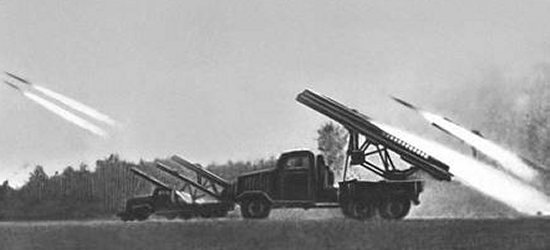
Soviet Katyusha rockets and their launchers
Production of these rockets continued after the war and included a variety of new types. Though technocally not Katyushas, newer rockets have continued to be referred to by this name. By far the most successful of these post-war weapons was the 122-mm BM-21 Grad deployed by the Soviet Army during the early 1960s. The Grad proved popular during a number of regional conflicts and was widely exported to over 50 countries. Among the nations to acquire these rockets were several Middle Eastern countries like Iran, Syria, and Egypt that used the weapons against Israel during the Six Day War of 1967. Iran, in particular, began building its own copies of the Soviet Katyusha as well as improved models and supplied many thousands of these to terrorist groups for attacks against Israel. Once manufactured in Iran, the rockets were transported through Syria to militants in Lebanon. Attacks began in earnest during the 1980s when Hezbollah, the Palestine Liberation Organization (PLO), and other groups launched hundreds of rockets into northern Israel. The attacks eventually led Israel to invade Lebanon to push the terrorist groups north and out of range of Israeli towns.
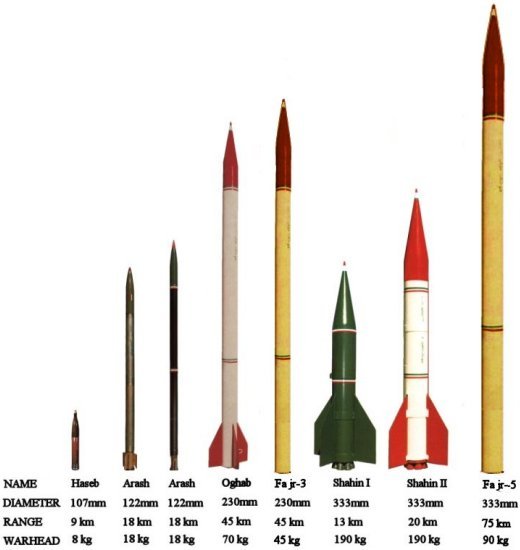
Comparison of Iranian artillery rockets
Once Israel completed its withdrawal from southern Lebanon in 2000, Hezbollah again reoccupied positions along the border to fire rockets south. The organization has also continued to receive a variety of more advanced rockets of greater range and destructive power from its sponsors in Iran. Though exact details are sketchy, it is believed that Hezbollah's stockpile includes older Katyusha rockets, known as the Arash in Iran, with a range of 12 miles (20 km) as well as improved third-generation rockets that can travel up to 50 miles (80 km). These improved models may include the Iranian 240-mm Fajr-3 with a 100-lb (45-kg) warhead and a range of 25 miles (40 km), the 333-mm Fajr-5 carrying a 200-lb (90-kg) warhead up to 45 miles (75 km), and the 333-mm Shahin-1 and Shahin-2 that can carry a 420-lb (190-kg) warhead over distances of 8 miles (13 km) and 12 miles (20 km), respectively. Iran has also apparently supplied Hezbollah with the very large Zelzal-2 rocket that can loft a 1,300-lb (600-kg) warhead as much as 125 miles (200 kg) bringing even cities in central and southern Israel within range of rocket attacks from Lebanon.
In 2004, the head of Israeli Military Intelligence estimated that Hezbollah's arsenal contains a total of 13,000 rockets. Most of these are the older Katyusha types with a range of 25 km or less while about 500 have a range of 45 km (Fajr-3) to 75 km (Fajr-5) and perhaps a few dozen are the Zelzal-2 model with a range of 115 to 200 km. Hezbollah also often refers to a rocket by the name Ra'ad-1, or "Thunder 1." It is believed that the Ra'ad-1 is another name for the Fajr-3.
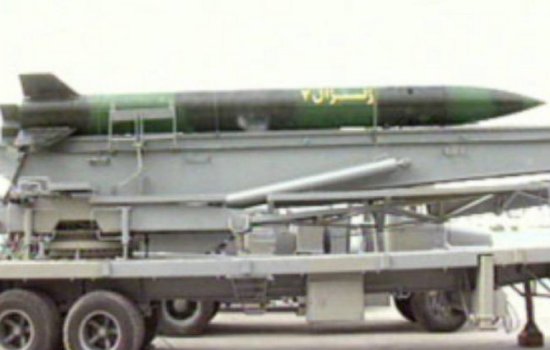
Iranian Zelzal-2 long-range rocket
While the Katyusha rockets used by Hezbollah are made in Iran, the Palestinians of the Gaza Strip have been building their own homemade rockets since about 2000. These rockets, developed by Nidal Fat'hi Rabah Farahat and Adnan al-Ghoul, are known as the Qassam (or Kassam) and were first used by Hamas terrorists in 2001. Hamas began constructing these weapons because of the strong security barriers surrounding the Gaza Strip that prevented direct raids on Israeli towns. The Qassam rockets are designed to fly over the barrier to strike population centers within Israel. The Qassam rockets are not nearly as advanced as those employed by Hezbollah, however, and both their range and explosive payload are quite limited.
Three different versions of the rocket have been seen so far. The Qassam 1 has a diameter of 60 mm, carries a warhead weighing 1 lb (0.5 kg), and has a maximum range of only 2 miles (3 km). Early attacks using these rockets failed because they landed inside the Gaza Strip itself rather than upon their intended targets. The first Qassam strike to hit an Israeli town occurred on 5 March 2002 when two of the weapons hit Sderot just north of the Gaza Strip. This community has taken the brunt of Qassam attacks given its close proximity to the Palestinian town of Beit Hanoun where most Qassam strikes are launched. The first fatalities caused by the rocket also occurred in Sderot on 28 June 2004 when two Israelis were killed.
The danger posed by Qassam attacks began to grow as improved versions were developed. The 150-mm Qassam 2 carries a warhead between 11 and 15 pounds (5 to 7 kg) over a distance of about 5 miles (8 km). The most advanced version seen so far is the Qassam 3 with a 170-mm body containing a 22-lb (10-kg) warhead and traveling as much as 6 miles (10 km). The farthest Israeli town attacked by late 2005 has been Ashkelon about 5 miles (8 km) from its launch point. Attacks using the improved Qassam 3 had succeeded in reaching the central part of Ashkelon by July 2006. The Qassam attacks have generally done very little damage and killed or injured just a handful of people since most of the rockets fall harmlessly in open areas.
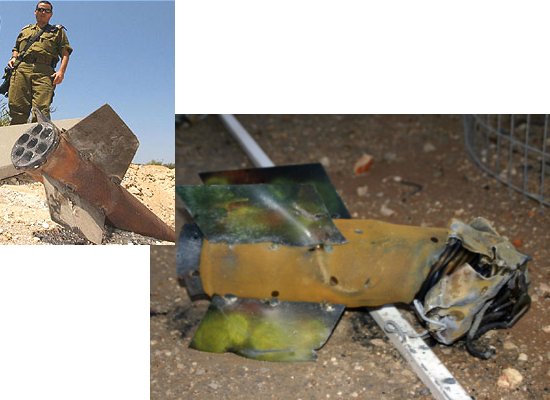
Wreckage of Qassam rockets in Israel
Although crude and inaccurate with a small payload and short range, the Qassam rockets have still caused significant concern in Israel because they are so difficult to protect against. Israel has acquired a defense system called Red Dawn that features a radar to detect the rockets at launch and sets off loudspeakers advising people in nearby towns to take cover. The system gives about 20 seconds of warning before the rocket strikes. It has also been reported that Israel will purchase a system from Switzerland called Skyshield to help prevent Qassam strikes. Skyshield is a rapid-fire anti-aircraft defense system designed to shoot down the rockets before they can reach civilian populations.
The increasing frequency of Qassam attacks has also prompted Israel to launch raids on the Gaza Strip to destroy facilities where the rockets are manufactured and launched. Israeli attacks have included strikes on terrorists, targeted assassinations of those developing the rockets, destruction of metal shops used to build the rockets, and clearing out orchards or farmland where the rockets are often launched. Among those killed in the attacks was Adnan al-Ghoul who was known as "Father of the Qassam." The Israeli attacks have included Army tanks and soldiers, Air Force aircraft, and Navy vessels firing shells from off the coast.
Despite these measures, the rockets used by the terrorist groups have improved substantially both in quantity and quality, and one of the greatest Israeli fears is that the technology will proliferate further. Though the Qassam rockets have proven little more than a nuisance, much larger and longer-ranged Katyusha rockets like those used by Hezbollah in Lebanon have begun to appear in the Gaza Strip as well. The first of these was launched by Islamic Jihad on 28 March 2006 and additional Katyushas are believed to have been smuggled into the region across the border with Egypt or by ship. Though none of the Katyusha rockets launched from Gaza have done any damage so far, the spread of these far more capable weapons into the Gaza Strip poses a serious threat to southern Israel.
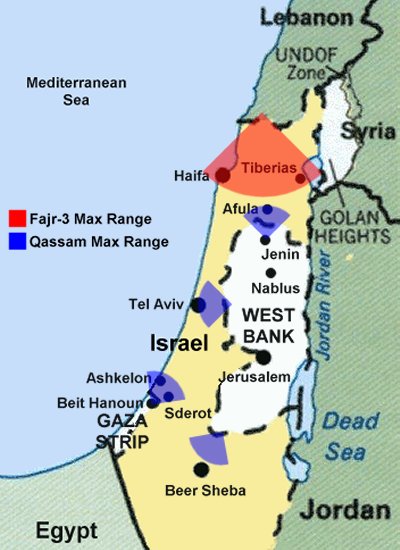
Areas of Israel currently or potentially threatened by Hezbollah and Hamas rockets
Even so, the areas attacked in rocket strikes from Lebanon and Gaza thus far are relatively sparsely populated. Of even greater concern is the possibility of rockets spreading to the West Bank. Since the majority of Israelis live in the central region of the country around Tel Aviv, even short-ranged Qassam and Katyusha rockets launched from the West Bank could threaten a large portion of Israel's population and industry. No rockets are believed to have been fired from the West Bank so far, but an Israeli raid on the town on Nablus in December 2005 discovered an explosives laboratory where Qassam rockets were being built. It is also known that Palestinians are attempting to smuggle rockets or their components into the West Bank as quickly as possible to launch a new wave of strikes.
Because rockets are relatively inexpensive, easy to build, simple to launch without detection, and difficult to defend against, they have become one of the most common forms of attack upon Israel since 2000. Tensions between Israel and the pro-Palestinian groups reached a new peak in 2006 when barrages of rocket attacks from both the Gaza Strip and Lebanon were stepped up dramatically. Hamas and other groups have launched over 800 Qassam rockets from Gaza since December 2005 leading to a series of Israeli raids on the region during June and July 2006.
Hostilities spread to Lebanon shortly thereafter when Hezbollah commenced its own full-scale rocket assaults on northern Israel. The conflict expanded rapidly as Hezbollah launched an estimated 760 rockets over just a four-day period from 12 to 15 July. These attacks have included the more advanced Ra'ad (Fajr-3) rockets and have reached as far south as the cities of Haifa and Tiberias some 20 miles (35 km) from the border. Eight people were killed in one attack on Haifa when a single rocket struck a railway maintenance depot.
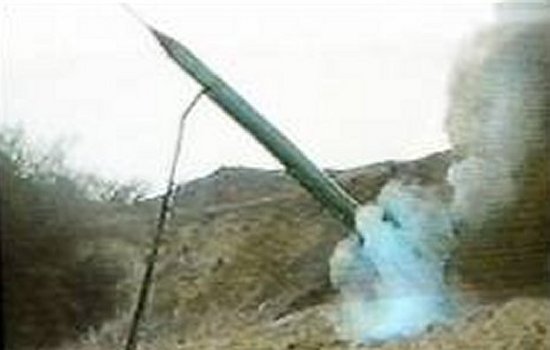
A rocket launched by Hezbollah
Perhaps even more troubling is the appearance of advanced missile technology in the region. On 14 July 2006, the missile corvette Hanit of the Israeli Navy was enforcing a blockade along the Lebanese coast when the vessel was struck by a C-802 anti-ship missile. Unlike the unguided Katyusha rockets, the C-802is far more sophisticated and includes an inertial and active-radar guidance system. The C-802 is an export version of the Chinese Yingji-82 missile and has been sold to Iran. Iran has reportedly developed its own copy of the Chinese missile and may have supplied these weapons to Hezbollah, though the Iranian government denies the accusation. Two of the advanced missiles were fired at the Israeli boat and one struck the vessel near its stern killing four sailors. The second apparently impacted an Egyptian freighter, though some reports suggest it was hit by a rocket instead. The freighter was sunk in the attack but the crewmen managed to escape and were rescued by other ships in the area.
Rumors have also surfaced suggesting that Iran has supplied Hezbollah with other advanced weapons like anti-tank and portable surface-to-air missiles. If true, these reports could herald a new era of increasingly sophisticated weaponry falling into the hands of terrorist organizations.
- answer by Jeff Scott , 16 July 2006
Read More Articles:
- Current Question of the Week
- Past Question Archive
- Most Popular Questions
- Search the Archive
- Submit a Question
